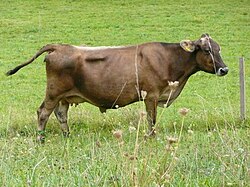This is a list of the cattle breeds usually considered to be of German origin. Some may have complex or obscure histories, so inclusion here does not necessarily imply that a breed is predominantly or exclusively from Germany.
| Name in German | English name if used | Notes | Image |
|---|---|---|---|
| Angler | Angeln | [1] : 48 [2] |  |
| Angler Rind alter Zuchtrichtung | extremely endangered [3] | ||
| Ansbach-Triesdorfer | extremely endangered [1] : 48 [2] [3] |  | |
| Berchtesgadener Katze | extinct | ||
| Braunvieh | [2] |  | |
| Braunvieh alter Zuchtrichtung [1] : 48 [2] | Original Braunvieh | gravely endangered [3] | |
| Deutsch Angus | German Angus | [4] : 183 |  |
| Deutsche Holstein Rotbunt | see Holstein Friesian [2] | ||
| Deutsche Holstein Schwarzbunt | see Holstein Friesian [2] |  | |
| Deutsche Rotbunte | |||
| Deutsches Schwarzbuntes Niederungsrind | German Black Pied | endangered [1] : 48 [2] [3] |  |
| Deutsches Shorthorn | gravely endangered [1] : 48 [2] [3] | ||
| Doppelnutzung Rotbunt | conservation status: alert [1] : 48 [2] [3] | ||
| Fleckvieh | [2] |  | |
| Fleckvieh Fleischnutzung | [1] : 48 [2] | ||
| Gelbvieh | endangered [2] [3] |  | |
| Gelbvieh Fleischnutzung | [2] | ||
| Glanrind | Glan | gravely endangered [1] : 48 [2] [3] |  |
| Grauvieh | [2] | ||
| Harzer Rotvieh | also Harzer Rote Höhenvieh |  | |
| Hinterwälder | Hinterwald | gravely endangered [2] [3] |  |
| Hinterwälder Fleischnutzung | [2] | ||
| Lakenvelder Rind | Lakenvelder | [2] |  |
| Limpurger | extremely endangered [1] : 48 [2] |  | |
| Murnau-Werdenfelser | Murnau-Werdenfels | extremely endangered [1] : 48 [2] [3] |  |
| Murnau-Werdenfelser Fleischnutzung | [2] | ||
| Pinzgauer | gravely endangered [2] [3] | ||
| Pinzgauer Fleischnutzung | [1] : 48 [2] | ||
| Rotes Höhenvieh | endangered [1] : 49 [2] [3] |  | |
| Rotvieh alter Angler Zuchtrichtung | [1] : 49 [2] | ||
| Schwarzbuntes Milchrind | German Black Pied Dairy | ||
| Uckermärker | [1] : 49 [2] |  | |
| Vogesen-Rind | [2] | ||
| Vorderwälder | Vorderwald | conservation status: alert [1] : 49 [2] [3] |  |
| Vorderwälder Fleischnutzung | [1] : 49 [2] | ||